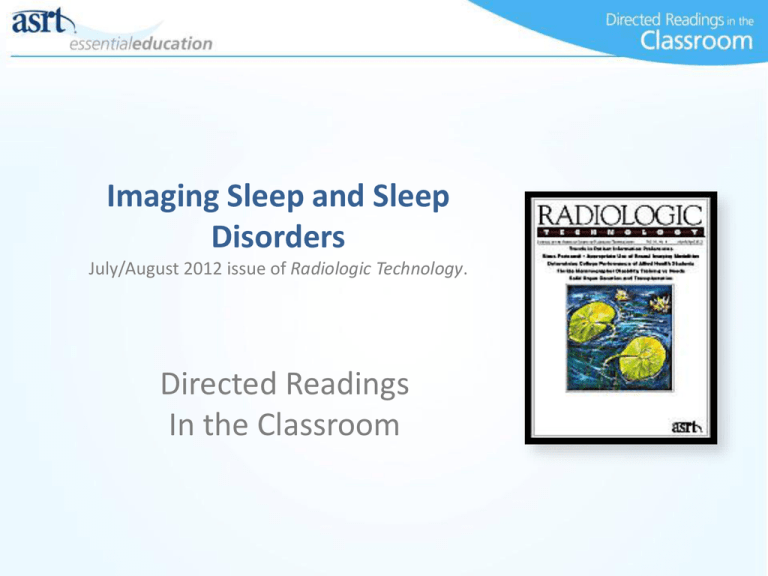Imaging Sleep and Sleep Disorders July/August 2012 issue of
advertisement

Imaging Sleep and Sleep Disorders July/August 2012 issue of Radiologic Technology. Directed Readings In the Classroom Instructions: This presentation provides a framework for educators and students to use Directed Reading content published in Radiologic Technology. This information should be modified to: 1. Meet the educational level of the audience. 2. Highlight the points in an instructor’s discussion or presentation. The images are provided to enhance the learning experience and should not be reproduced for other purposes. Objectives • Explain the importance of sleep, including what it achieves in terms of physical and mental well-being. • Identify the components of sleep. • Describe how imaging helps experts dissect sleep and understand the genesis and effect of sleep disorders. • Explain how sleep deprivation relates to other physical and mental diseases and disorders. • Promote greater awareness among health care professionals of the dangers of sleep deprivation. What Is Sleep? Sleep is “a period of rest for the body and mind, during which volition and consciousness are in partial or complete abeyance and the bodily functions partially suspended.” It also is described as part of a homeostatic regulation of the body. The homeostatic regulation of neurons, glial cells (the supporting structure of nervous tissue), and brain vasculature that occurs during sleep is vital to the maintenance of health, adaptability, and cognitive performance. Sleeplessness Sleeplessness can severely diminish the quality of one’s life and also can affect his or her family life. When sleep is disrupted or eliminated, we suffer on more than the visible, everyday level. Circadian Rhythms Our bodies maintain sleep and resting, healing properties by means of circadian rhythms. Circadian rhythms are a form of internalized body regulation — a 24-hour clock that creates a predictable schedule of sleepiness. Day to day, we naturally, rhythmically become fatigued, and that fatigue triggers changes that help us to fall and stay asleep. Circadian Rhythms Circadian rhythms play a part in regulating core body temperature, urine output, hormones, learning, and memory. Disruption in the control mechanisms of homeostasis and circadian rhythms can have a deleterious effect on sleep and sleep quality. Sleep Architecture Sleep architecture, or the structure of sleep, is composed of the cyclical stages of sleep. When we fall asleep, we dissociate ourselves from the external world. Alpha brain waves, which signal a relaxed wakefulness, diminish in amplitude as we approach the onset of sleep. The practices of meditation and yoga, and the relaxation brought on by alcohol consumption, also may produce alpha waves — we are awake, but relaxed. The power of alpha waves fluctuates throughout the night and corresponds with the depth of sleep. Sleep Stages Experts categorize sleep into 2 main stages or components: rapid eye movement (REM) and nonrapid eye movement (NREM). A complete, healthy sleep is composed of 4 to 6 cycles of REM and NREM sleep per night, with 90 minutes of sleep per cycle. Sleep disorders can increase the frequency of sleep stage transitions and decrease the duration of time spent in certain sleep stages. Dreams Dreams are prominent during REM sleep, which consumes between 18% and 22% of total sleep time; however, REM sleep duration decreases slightly as we age. We experience the most REM sleep toward the end of sleep, in the morning, because of circadian rhythm controls. Sleep Imaging All stages of sleep and wakefulness have been examined using fMR imaging, which can reveal fluctuations in blood oxygenation level-dependent (BOLD) signal. It permits comparison of the varied engagement of different brain areas and networks in wakefulness, light sleep, children, anesthetized and comatose individuals, and primates. For example, rapid eye movements that take place at the start of REM sleep appear to activate the prefrontal cortex, which is likely connected to the dream state, although study results differ with respect to activation of this brain region. Imaging and Sleep Architecture PET has proved a noninvasive technique capable of revealing information about functional activity across all regions of the brain during sleep. Using PET across the entire sleep-wake cycle, researchers can investigate associated metabolic and biochemical processes both to visualize and quantify functional activity in all brain regions. MR vs PET In comparison with MR, PET has the advantage of producing a low level of noise, thus permitting more natural sleep for research subjects. Compared to PET, fMR provides improved spatial and temporal resolution and it does not require the injection of radioactive agents. Still, the scanner is an uncomfortable, noisy environment that is not conducive to sleep. The Functions of Sleep Experts characterize sleep as a dynamic time for various brain functions that promote memory and cognition, attention, emotional processing, and physiological repair and renewal of the body. All stages of sleep involve some degree of brain activity and spontaneous firing of neurons. We also know that sleep deprivation can lead to or even be symptomatic of various comorbid disease conditions. Restoration and Renewal PET, near infrared spectroscopy, and fMR imaging have revealed that when the brain’s neurons fire they summon blood and metabolites, and the blood vessels stretch and become less compliant. During sleep, when the metabolic demand is reduced, vessels relax, allowing for repair and a continued ability to deliver blood the next day. Sleep promotes the brain’s ability to repair and refresh neural synapses and to engage in synaptic remodeling. Emotional Processing Sleep profoundly affects the consolidation of emotional memories. dysfunctional processing of events can lead to inappropriate risk-taking behaviors such as addiction and emotional imbalances or mood disorders. Chronic sleep deprivation increases mood disturbance and heightens the incidence of emotional difficulties. Sleep deprivation also disrupts the processing of negative emotional memories, when we are sleep deprived, we find it hard to “get over” insults or painful events. Emotional Processing Lack of sleep also may be associated with an increased neural reactivity to positive emotional experiences. In an experiment conducted at the Sleep and Neuroimaging Laboratory at the University of California, Berkeley, participants underwent fMR scanning while viewing emotionally neutral to increasingly pleasant images and were asked to categorize images as either pleasant or neutral. Sleep-deprived individuals rated significantly more images as pleasant and significantly fewer images as neutral. In the sleep-control group, there was no difference between the subjects’ ratings of positive and neutral images. Memory and Cognition Sleep plays a powerful role in memory and perception of events observed and learned. Acute sleep deprivation has been shown to create false memories and memory distortion. Studies have demonstrated that sleep deprivation modulates short-time perception in humans. Lack of a single night of sleep can lead to an inability to maintain sustained attention and to slow cognitive processing. PET and fMR studies have led experts to conclude that NREM and REM sleep differentially promote the consolidation of memories. Sleep Disorders Experts have identified more than 90 sleep disorders, and some occupations such as shift work render workers particularly susceptible to sleep disturbances. Sleep disorders often are the result of complex interactions between genetic predispositions and environmental factors, such as lack of exercise and unhealthy food habits. Obstructive Sleep Apnea Obesity is strongly associated with the prevalence of obstructive sleep apnea (OSA).OSA is characterized by anatomical and functional abnormalities in the upper airway that cause breathing irregularities (intermittent hypoxia) and affect blood flow and oxygen to the brain. Snoring can be a symptom of OSA, and imaging studies have revealed evidence of brain morphological changes resulting from OSA, including loss of gray matter and reduced brain metabolism. Childhood OSA A study using MR spectroscopy examined whether childhood OSA could be associated with dysfunction in neuropsychological performance. In a study comparing sleep apnea pediatric patients to children subjects in the control group, MR findings indicated children with OSA had possible neuronal injury in the hippocampus and right frontal cortex. The children with OSA also had significantly lower intelligence quotients and executive control functions. Insomnia Insomnia is the most commonly reported sleep problem worldwide, with prevalence falling between 10% and 35% of adults. Patients have trouble falling to or maintaining sleep, wake up too early, or have relentlessly poor and nonrestorative sleep. SPECT and PET studies of patients with insomnia during sleep and wakefulness support autonomic nervous system hyperarousal as the most compelling explanation for insomnia. Sleep Disorders and Health Care Workers Professional burnout is possible in all jobs, and warning signs are important to note. The American College of Radiology listed “clinical indicators” of burnout as cynicism, anger, irritability, sleep disturbances, exhaustion, and a reduced sense of personal accomplishment. The organization emphasized the need to eat well, exercise, rest, and “not skimp on sleep” to prevent or reduce burnout. Sleep Disorders and Health Care Workers Finding a healthy balance between work and personal life might mean making less money and working less, and also might include: • • • • • • Spending more time with supportive friends and family. Engaging in religious or spiritual activities. Focusing on success, not problems. Having adequate administrative support and understanding. Being in a workplace that emphasizes balance between work and personal lives. Maintaining good nutrition and exercise. Conclusion At this point, it appears that we only can see the tip of the iceberg in terms of what sleep means to us and what it accomplishes for our mental and physical wellbeing. Researchers will continue to use imaging to decipher the implications of sleep and help us to achieve more healthful, full, and restorative sleep. In the meantime, the message is clear: Sleep is vital, and we possess many tools that can help us create better sleep experiences. As individuals and as a culture, we can emphasize exercise, weight control, a more measured use of technology, and a good balance between work and play. Discussion Questions Thinking about the different options used to image sleep disorders, what are the pros and cons of each option? Discuss some of the effects insufficient sleep can have on children. Discuss ways health care workers can avoid burnout. Additional Resources Visit www.asrt.org/students to find information and resources that will be valuable in your radiologic technology education.







